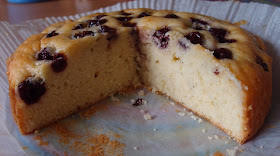
Mr CC and I have just returned from a splendid jaunt to Whitby; a beautiful town on the rugged North York coast. It is also the inspiration and setting for Bram Stoker’s Dracula.

My cake this week is therefore Yorkshire-themed. Cobles are open fishing boats, with flat bottoms, commonly sighted on the North York coast. This cake is named after them but doesn’t seem well documented – there are some mentions but I couldn’t find a recipe anywhere on the internet. The cake is a spiced sponge, filled with apple puree and served with cream. This was all the detail I needed to produce my own version!

I was tempted to whip the cream and fill the sponge with it, along with the apple puree but I think this wouldn’t have produced such an elegant finish. I also considered stirring the apple puree through the cream but again, I wanted to keep the flavours distinct.

The one thing that the internet seems in agreement about re: Coble cake is that it needs to be served with cream. I was happy to oblige:

There were some lovely tea rooms in Whitby; one thing we noticed very quickly was that the region hasn’t got much time for fancy patisserie, favouring good hearty cakes in – and remember this is me saying this – hearty portions! We enjoyed, amongst other things, a toasted teacake so huge it took both hands to lift it to my mouth! I took the biggest bite I could out of one half (for photographic purposes only, obviously) – it barely made an indent:

I think our serving of chocolate cake and flapjacks highlights the generosity of Yorkshire portions. There aren’t many places where TWO flapjacks are considered the standard serving! Also notice how the chocolate cake is only just contained within the boundaries of the plate:

Another highlight was this toffee apple betty cake – the flavours were a delight and I loved how the apple was layered in the middle section:

This scone was lovely – unusually for me I chose to have it with butter and jam rather than cream and jam:

Mr CC was pleased with his carrot cake...and who wouldn’t be, having a triple-decker slice like this put in front of them?

Ingredients
For the cake:
250g unsalted butter, at room temperature
220g golden caster sugar
4 eggs
80ml milk
300g self raising flour
1 teaspoon ground ginger
1 teaspoon ground cinnamon
½ teaspoon freshly grated nutmeg
1 ½ teaspoon mixed spice
For the apple puree (puree is never an exact science so make whatever quantity you wish – it freezes brilliantly); however for this cake I used:
1-2 Bramley apples
10 tablespoons caster sugar – or to taste
Water
To serve: thick or whipped cream
Method
Preheat the oven to 180°C/fan oven 160°C/350°F/Gas mark 4.
Line two 20cm round loose bottomed sandwich tins with baking paper.
Start by making the sponge: Beat together the butter and sugar until light and fluffy. Don’t skimp on this stage as this is when you get lots of lovely air into your sponge.
Beat in the eggs gradually, adding some of the flour if it looks like it might curdle.
Beat in the milk.
Fold in the flour and all the spices until the mixture is smooth and well combined.
Spoon into the prepared tins and level the surface.
Bake for approximately 30 minutes or until a skewer inserted into the centre of the sponge comes out clean. Another good sign is if the sponge is just pulling away from the edge of the tin.
Leave to cool in the tin for about 20 minutes before turning out and leaving to cool completely on a wire rack.
Meanwhile, make the apple puree. Take a saucepan of appropriate size – roughly so that the apples will half fill the pan.
Cover the bottom of the pan with water – ideally about 2cm deep.
Peel, core and thinly slice the cooking apples.
Slowly simmer until the apples break down and you have a puree; if the pan looks dry add some more water. You can speed this up placing the pan lid 3/4s over the pan.
Personally, I like my puree with some apple chunks still in it; if you don’t cook until smooth.
Add the sugar right at the end – this is totally to taste so add gradually until you have the right sweetness for you.
When you are ready to assemble the cake place one sponge layer, flat side up, on the serving plate.
Spread the apple puree over the sponge and then sandwich with the second sponge, flat side down.
If you wish, dust the top sponge with icing sugar.
Serve in generous slices with whipped cream.
Bask in the glory of the wonderful thing you have made.
Eat.




































